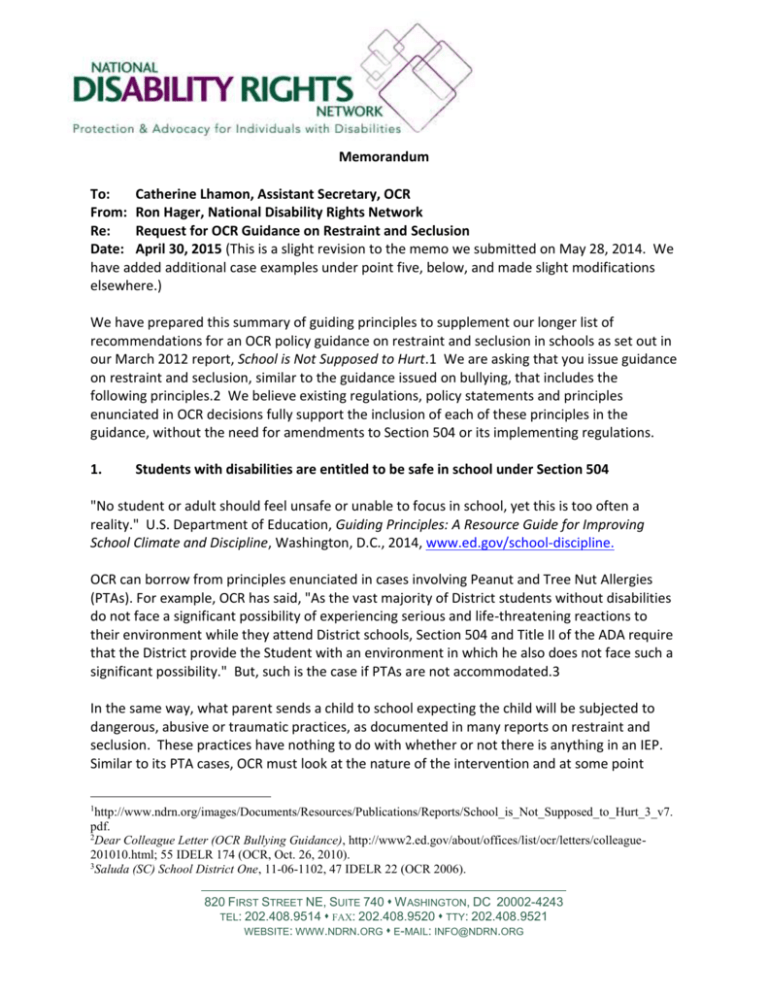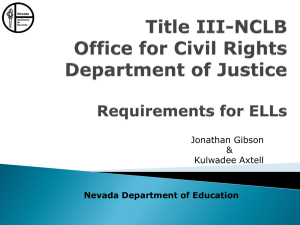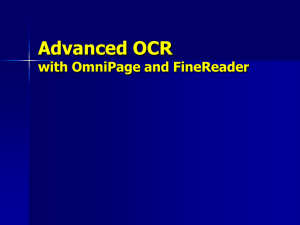Handout #1 - Region 4 | Parent Technical Assistance
advertisement

Memorandum To: Catherine Lhamon, Assistant Secretary, OCR From: Ron Hager, National Disability Rights Network Re: Request for OCR Guidance on Restraint and Seclusion Date: April 30, 2015 (This is a slight revision to the memo we submitted on May 28, 2014. We have added additional case examples under point five, below, and made slight modifications elsewhere.) We have prepared this summary of guiding principles to supplement our longer list of recommendations for an OCR policy guidance on restraint and seclusion in schools as set out in our March 2012 report, School is Not Supposed to Hurt.1 We are asking that you issue guidance on restraint and seclusion, similar to the guidance issued on bullying, that includes the following principles.2 We believe existing regulations, policy statements and principles enunciated in OCR decisions fully support the inclusion of each of these principles in the guidance, without the need for amendments to Section 504 or its implementing regulations. 1. Students with disabilities are entitled to be safe in school under Section 504 "No student or adult should feel unsafe or unable to focus in school, yet this is too often a reality." U.S. Department of Education, Guiding Principles: A Resource Guide for Improving School Climate and Discipline, Washington, D.C., 2014, www.ed.gov/school-discipline. OCR can borrow from principles enunciated in cases involving Peanut and Tree Nut Allergies (PTAs). For example, OCR has said, "As the vast majority of District students without disabilities do not face a significant possibility of experiencing serious and life-threatening reactions to their environment while they attend District schools, Section 504 and Title II of the ADA require that the District provide the Student with an environment in which he also does not face such a significant possibility." But, such is the case if PTAs are not accommodated.3 In the same way, what parent sends a child to school expecting the child will be subjected to dangerous, abusive or traumatic practices, as documented in many reports on restraint and seclusion. These practices have nothing to do with whether or not there is anything in an IEP. Similar to its PTA cases, OCR must look at the nature of the intervention and at some point 1 http://www.ndrn.org/images/Documents/Resources/Publications/Reports/School_is_Not_Supposed_to_Hurt_3_v7. pdf. 2 Dear Colleague Letter (OCR Bullying Guidance), http://www2.ed.gov/about/offices/list/ocr/letters/colleague201010.html; 55 IDELR 174 (OCR, Oct. 26, 2010). 3 Saluda (SC) School District One, 11-06-1102, 47 IDELR 22 (OCR 2006). 820 FIRST STREET NE, SUITE 740 W ASHINGTON, DC 20002-4243 TEL: 202.408.9514 FAX: 202.408.9520 TTY: 202.408.9521 WEBSITE: WWW.NDRN.ORG E-MAIL: INFO@NDRN.ORG determine whether it must be considered discriminatory harassment, regardless of whether or not the intervention is in the IEP. When harassment creates a "hostile environment" and is based on race, color, national origin, sex, or disability it violates civil rights law. A hostile environment is created when "the conduct is sufficiently severe, pervasive, or persistent so as to interfere with or limit a student's ability to participate in or benefit from the services" offered by the school. OCR Bullying Guidance, p. 2. 2. OCR can adopt the Department's educational finding that restraint or seclusion are not effective at reducing negative behaviors, and, therefore, to apply restraint or seclusion as a planned intervention would violate the ant-discrimination provisions of Section 504 The Department of Education has unequivocally stated that there is no evidence that restraint or seclusion is effective in reducing the very behaviors that frequently precipitate the use of such techniques. U.S. Department of Education, Restraint and Seclusion Resource Document, Washington, DC (May 2012), p. 2, www.ed.gov/policy/restraintseclusion (R&S Resource Document). This finding by the Department is entitled to deference. Therefore, to use restraints or seclusion to attempt to improve behavior would not be educationally justified, especially when there are effective alternatives as set out in the resource document. We believe to administer restraint and seclusion in these circumstances would amount to discrimination under 34 C.F.R. 104.4: The implementing regulation for Section 504 at 34 C.F.R. § 104.4 provides that students with disabilities shall not, on the basis of disability, be excluded from participation in, be denied the benefits of, be afforded an opportunity that is not equal to that afforded others, or otherwise be subjected to discrimination. The regulation further provides that a recipient may not otherwise limit an individual in the enjoyment of any right, privilege, advantage, or opportunity enjoyed by others receiving an aid, benefit, or service. Letter of Findings, North Carolina Charter School, OCR Complaint No. 11-13-1xxx, p. 3 (Jan. 30, 2014) (emphasis added). 3. OCR can Adopt the Department's Definitions of FBAs and BIPs Again, the Department’s definitions of an FBA and a BIP are entitled to deference. An FBA is an assessment that attempts to determine what purpose the behavior serves for the student and to find alternative ways for the student to fulfill the same need. An FBA analyzes environmental factors that contribute to a student's inappropriate behaviors and the FBA data is to be used to develop positive behavioral strategies to address the behavior. R&S Resource Document, p. 17. 2 A BIP is used to pro-actively address the student's inappropriate behaviors. It is based on a functional behavioral assessment (FBA). A BIP should describe strategies to: (1) (2) (3) (4) (5) (6) address characteristics of setting and events, remove antecedents that trigger inappropriate behavior, add antecedents that maintain appropriate behavior, remove consequences that maintain or escalate inappropriate behavior, add consequences that maintain appropriate behavior, and teach appropriate alternative behaviors, including self-regulatory techniques. R&S Resource Document, p. 18. 4. OCR can require that schools fully evaluate students in all areas of suspected disability and develop an IEP or Section 504 Plan that addresses all of the areas of need In East Side (CA) Union High School District, 52 IDELR 269 (OCR March 20, 2009) OCR determined that the evaluation and placement process did not comply with Section 504. It noted: The District conducted an evaluation that tested the Student's cognitive capabilities, her achievement, her visual and auditory processing skills, and her adaptive behavior. However, neither the evaluation report nor the IEP itself include any analysis of these results as they apply to the problems of attention, concentration and emotionality that in large part triggered the assessment request. Despite a behavior assessment that reveals significant concerns about attention, impulsivity and depression; teacher comments that indicate a consistent need for prompting to stay on task; and a sustained record of failing most of her academic courses, the evaluation report does not discuss the impact of the Students attention problems on her ability to understand and participate in her classes or to complete her classwork or homework. Instead, the "recommendations" of the report focus almost entirely on the student's eligibility for services as a student with a specific learning disability. Similarly, the Student's IEP includes a determination of the Students eligibility category and her need for mathematics instruction through resource specialist services, but no discussion of problems of concentration or attention and no services that might be expected to address these issues. This decision is based on the evaluation and placement procedures in 34 C.F.R. 104.35 and the use of these procedures in 34 C.F.R. 104.33(b)(1) for a district to meet its FAPE obligations under Section 504. Therefore, OCR should indicate that when a student’s behavior rises to the point that the district believes restraint or seclusion is necessary, it must ensure that it has fully evaluated the student in all areas of suspected disability and developed an IEP or Section 504 Plan that fully addresses all identified areas of need. 3 5. OCR can require that when student behavior is sufficiently severe for a district to believe that use of restraint or seclusion is necessary, that the district conduct or revise an FBA and BIP that meets Education Department standards or take other appropriate steps to address the behavior Building on the principles above, if a student's behavior is sufficiently severe to warrant the use of restraint or seclusion, it is difficult to imagine how the district could be meeting its FAPE obligation under Section 504, if it does not take steps to reduce the underlying behavior. This is the underlying rational for a number of recent OCR letters of finding as well as its recent Dear Colleague Letter: Responding to Bullying of Students with Disabilities (Responding to Bullying) (OCR October 21, 2014), http://www2.ed.gov/about/offices/list/ocr/letters/colleague-bullying201410.pdf. In Responding to Bullying, p. 5, OCR noted that school districts have an ongoing obligation to ensure that a student receiving services under either the IDEA or Section 504 continues to receive FAPE. Even though this statement was made in the context of responding to student bullying, OCR made it clear that it was not limited to the bullying context, as OCR noted that the ongoing obligation to provide FAPE exists regardless of the basis for the bullying or even whether or not the district “knew or should have known about the bullying.” Responding to Bullying, p. 11. In its example, OCR noted that a sudden decline in the student’s grades as well as changes in her behavior were sufficient to put the school on notice of its obligation to promptly convene the Section 504 team to determine the extent of the FAPE-related problems and to make any necessary changes to her services, or, if necessary, reevaluate her, in order to ensure that she continues to receive FAPE. Id. OCR should make it clear that a school district’s obligation to continue to provide FAPE applies to a student that is being restrained or secluded. The district must take the steps necessary to address the underlying behavior. This is essentially the approach OCR took in the North Carolina Charter School case, referred to above. The student had been restrained repeatedly over the course of the school year because of his significant behavior problems. The IEP team met numerous times during the course of the year, and was attended by numerous people, including teachers, a counselor, day treatment therapists, and a behavior specialist. Nevertheless, OCR found that the school violated the procedural requirements for developing an IEP or Section 504 plan and the student was not provided a FAPE. OCR noted that “the appropriate use of restraint, or alternative behavioral tools, was never considered by the Student’s IEP team.” Id. P.7. Additionally, there never was “a discussion of providing the Student with counseling or any other aid or service related to his behavioral disability.” Id. Other concerns mentioned in the Letter of Finding include: 1) not conducting any meaningful evaluation of the student’s behavior or making any significant changes to the BIP even though the student’s behavior continued to deteriorate; 2) not having staff with appropriate behavioral expertise participate in the IEP or Section 504 4 meeting; and, 3) not considering a different educational placement for the student, in line with LRE requirements. We believe the principles enunciated in this case would provide an excellent foundation for guidance on restraint and seclusion. Similarly, in Prince William (VA) County Schools Letter of Finding, OCR Complaint No. 11-131058 (OCR July 29, 2014), OCR determined that a program for students with serious emotional and behavioral problems did not provide FAPE to students through its frequent use of restraint, seclusion and placement in a time out area. OCR determined that 1) students did “not have individualized plans with specific behavioral interventions designed to meet their individual needs;” 2) students did not have access to the curriculum when placed in restraint, seclusion or time out; and 3) that “the frequency with which many of the students continue to act out behaviorally despite, or possibly even because of, the use of these interventions” gives the program “reason to believe it should re-evaluate individual students” to ensure it is meeting their needs; 4) staff used “restraint and seclusion broadly to respond to disruptive behaviors;” 5) staff failed to conduct a “systematic review of each incident;” 6) staff failed to consider whether less restrictive interventions were available to address behavior; and 7) the program failed to convene a group of knowledgeable people to examine whether additional evaluations or a change of placement or services was “needed, as required by Section 504.” Id. P. 5, 7 (emphasis added). OCR also noted that although Section 504 does not require parental participation in placement decisions, they generally are among the individuals knowledgeable about the student and his or her disability. It noted the importance of notifying the parents as soon as possible after each incident of restraint or seclusion, so that parents are in a position to participate in the process of ensuring a school is meeting the child’s individual needs in providing a FAPE. This is particularly true because inadequate parental notification can contribute to lack of relevant information about the student’s individual behavioral needs. Id. P. 8. Again, we believe that OCR’s findings in this case should be used in OCR guidance. 6. School districts should be advised that significant disparities in restraint and seclusion rates could be the sign of discrimination under a disparate treatment or disparate impact theory The joint DOJ/OCR Discipline Dear Colleague Letter laid out how statistical disparities could show a violation of Title IV or Title VI. The Letter pointed out that a similar analysis could be applied to discipline under Section 504. In Schenectady (NY) City School District, 113 LRP 43955 (OCR, Oct. 30, 2013) OCR found disparate treatment in referral rates for black and Hispanic students because, during its compliance review, it found 14 examples of different treatment in student referrals based on race or national origin. Id. p. 5. These principles would apply equally to statistical disparities in the uses of restraint or seclusion, which based on the CRDC we know to be extremely problematic. 5







